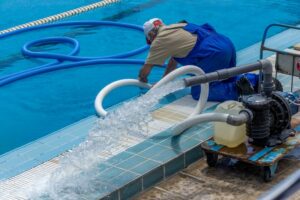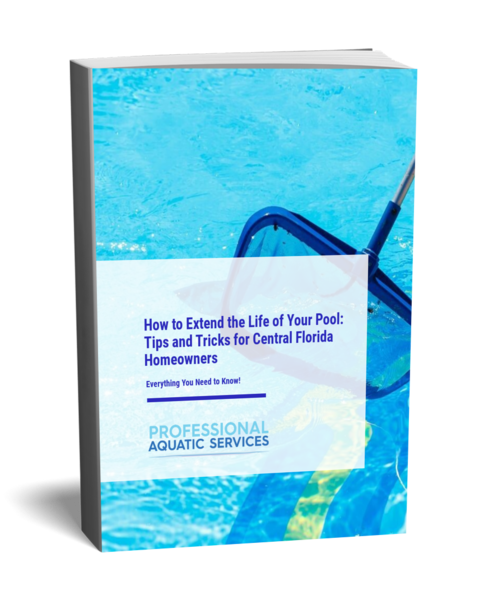Every splash in your swimming pool relies on your pool equipment—the pool pumps. As a pool owner, you’re familiar with its hum, working tirelessly to circulate water through filters, heaters, and other parts of your system. But have you considered the pool pump costs affecting your energy bills? Whether enjoying a serene swim or hosting a lively pool party, an energy-efficient variable speed pump could be the key to saving on electricity while keeping your waters pristine.
Upgrading to a new pump, especially from a single-speed to a dual or variable-speed pool pump, isn’t just about being energy-conscious—it’s about being cost-conscious. Regular maintenance of your pump, alongside the right size and type of pool filter, can significantly lower the costs of running your swimming pool. It’s essential to double-check that your pump matches your pool’s volume and any water features, as this influences power use and, importantly, your wallet.
So, let’s dive into how a new pool pump can be a game-changer for both your pool and your energy bills.
Table of Contents
ToggleUnderstanding Pool Pumps
When you think of pool equipment, the pool pump should come to mind first. Acting as the heart of your swimming pool, the pump is responsible for circulating pool water through the filter, ensuring that your swim experience is clean and refreshing.
The Lifeline of Pool Maintenance
Every pool owner knows that clear water doesn’t happen by accident. It’s your pool pump that works round the clock, pulling water in, pushing it through the pool filter to trap dirt and debris, and then circulating it back—clean and inviting—into your pool. It’s not just about cleanliness. The pump also ensures the even distribution of chemicals and the proper function of water features, making it an indispensable part of swimming pool maintenance.
Evolving Pump Technologies
Traditionally, most pool owners have relied on a single speed pump, known for their constant high speed and equally high energy use. However, times are changing. Energy-saving pool pump technology, like variable speed pumps, is taking the lead. These modern marvels adjust their speed to your pool’s needs, which means they consume less power and can drastically reduce pool pump cost.
By investing in a new pool pump that’s eco-friendly, you’re not just upgrading your pool system. You’re investing in lower electricity bills and a healthier environment. Whether installing a new pump or repairing an old one, understanding the difference in technology is your key to making an informed decision that pays off in the long run.
Benefits of Energy-Efficient Pool Pumps
Switching to an energy-efficient pool pump is like choosing a hybrid car over a gas guzzler—it’s an investment that brings many benefits to both of you, the pool owner, and the environment.
Save More Than Just Water
Your swimming pool will not only be a place of relaxation but also a testament to eco-friendliness. By requiring less power, an energy saving pool pump reduces your carbon footprint. It’s a simple yet impactful way to contribute to environmental conservation efforts while enjoying your swim.
Durability Meets Performance
Moreover, these pumps are designed for longevity and better performance. With less strain on the motor and more precise control over water flow, they ensure that your pool water stays clean and your pool equipment, like filters and heaters, endures less wear and tear. The result? Swimming pools are not just a joy to use but also more manageable and less costly to maintain in the long run.
Features of Energy-Efficient Pool Pumps
If you’re considering a new pool pump, you’ll want to be well-versed in the features that make energy-efficient models a smart choice. Let’s explore what sets these pumps apart and how they can transform how you maintain your pool.
Variable Speed Options
Variable speed pumps give you the flexibility to adjust the water flow through your pool system. Unlike the constant high speed of traditional pumps, these innovative devices can dial down to a gentle flow or ramp up to a powerful current as needed. And for those not ready to leap to fully variable speed pumps, dual speed pool pumps offer a middle ground, with settings for both low and high speed that can be manually adjusted based on your pool’s demands. The result? You only use the energy you need, keeping pool pump costs in check and ensuring your pool water is circulated effectively.
Automated Control System
Modern energy-efficient pumps often come with automated control systems. This intelligent technology can detect the optimal operating levels for your swimming pool, adjust the speed on its own, and even set a schedule for the pump’s operation. This hands-off approach isn’t just convenient—it also optimizes energy use and can lead to significant savings on labor and repair costs.
High Efficiency Motors
At the heart of energy-efficient pool pumps are high-efficiency motors that provide maximum power with minimal electricity use. These motors run cooler, last longer, and contribute to overall lower pool pump costs. By installing a pump equipped with a high-efficiency motor, you’ll ensure that your swimming pool’s heart beats more robustly for longer, all while trimming down that electricity bill.
Is Your Pool Pump Powering Through Efficiently?
Keeping an eye on the efficiency of your pool equipment is vital to ensuring a cost-effective and eco-friendly swimming experience. Let’s dive into how you can assess the energy efficiency of your pool pump and recognize when it’s time for an upgrade.
Assessing Current Pool Pump Performance
Start by checking your pool pump’s current performance. Is it struggling to keep the pool water clear? Does it make more noise than usual, or does it run longer hours to accomplish the same job? These could be signs that your pump is losing its efficiency. Consider the age of your pump as well—most pool pumps have a lifespan of 8-10 years. If yours is older, it may be time to consider its retirement.
When to Consider Upgrading
- Energy Bills: Notice a steady increase in your energy bills? A less efficient pump could be the culprit.
- Pool Volume and Usage: If you’ve added water features or increased pool usage and your pump is struggling, it may be undersized or outdated.
- Technology Advancements: Newer models, especially variable speed pumps, offer significant energy savings compared to older, single-speed models.
- Repair Frequency: Are repairs becoming more frequent and costly? Investing in a new pump might be more economical.
- Noise Level: A louder operation can indicate wear and inefficiency.
- Performance: If your pool water is less clean than it used to be, even with regular maintenance, your pump’s efficiency could decrease.
- Upgrading Your Pool: Installing a new pool heater or pool cleaners? Make sure your pump can handle the added workload.
Regularly evaluating your pump’s efficiency and being aware of these key indicators can help you make an informed decision on whether to replace or repair it. Upgrading a more efficient model could lead to better performance, reduced costs, and a happier pool environment.
Pool Pump Repair or Replacement?
At some point, every pool owner decides: should you opt for pool pump repair that was chugging an old pump or replace it altogether? The right choice can save you money and improve your pool’s performance.
Understanding the Lifespan of Pool Pumps
A pool pump typically has a healthy life of about 8 to 12 years. However, their longevity depends on several factors, including usage patterns, regular maintenance, and the quality of the pump’s installation.
Recognizing the Signs for Repair
Your pump might need attention if you notice unusual noises, a drop in water flow, or if it’s not priming properly. Also, if the motor runs hot or trips the circuit breaker, it’s a sign to call in a professional.
Weighing Repair Costs
Repairs can range from replacing worn gaskets to fixing a faulty motor. While small fixes are generally cost-effective, be wary if repair estimates start approaching half the cost of a new pump.
When to Opt for Repair
Repair is a viable option when:
- The pump is relatively new.
- The issue is minor, like a seal replacement.
- The overall condition of the pump is good.
Deciding Between Repair and Replacement
Consider these points to find the break-even:
- Age of the Pump: If it’s over halfway through its expected lifespan, replacement might be more economical.
- Cost Comparison: Get estimates for both repair and replacement. If repairs cost more than 50% of a new pump, go for the upgrade.
- Energy Efficiency: Newer models are more energy-efficient; replacing them could save energy bills.
Balancing the immediate cost against long-term savings and performance can help you decide whether to repair your trusty pump or invest in a new, energy-efficient model. Remember, sometimes spending a bit more today means substantial savings tomorrow.
Keeping Your Pool Pump in Top Shape
Consistent maintenance is the key to extending the life of your pool pump and avoiding unnecessary pool pump cost down the line. Here’s how to keep your pump running smoothly.
Routine Maintenance for Optimal Performance
You should make it a habit to regularly check and clean your pool filters—whether cartridge, DE, or sand filters. A clogged filter increases the load on your pool pump. Also, monitor the pump basket and clear any debris to prevent blockages. Listen to your pump; any strange noises could indicate a problem that needs prompt attention.
Common Issues and Troubleshooting
If your pump is losing power or your electricity bill is creeping up, it could be a sign that it is working harder than it should. Check for leaks, cracks, or wear in the hoses and connections. Ensure the pump’s motor isn’t overheating, and the circuit breaker isn’t tripping frequently. If you need more clarification, consult a professional. Sometimes, a simple repair can save you from the cost of installing a new pump.
By paying regular attention to your pool pump and addressing minor issues promptly, you can save both gallons of water and dollars on repairs, ensuring your pool remains a refreshing escape for years to come.
Connect with a Trusted Local Pool Equipment Installation Service

In wrapping up, remember that investing in an energy-saving pool pump is not just a smart move for your wallet, but it’s also kind to the planet. The cost benefits are clear: reduced energy bills and less frequent repairs. As you consider upgrading, don’t go it alone—reach out to the experts. Professional Aquatic Services specializes in pool repair and pool pump installation, ensuring that your transition to a more efficient system is smooth and professionally handled. With their help, you can enjoy the full spectrum of benefits that come with a new, energy-efficient pool pump.

